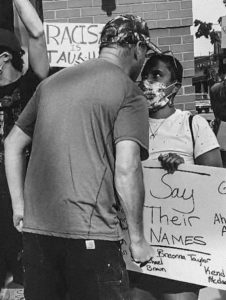My last post was a start to a discussion about racism in America. This is the second. I’m not yet sure how many posts I’ll have in this series. For sure one more after today and perhaps two, depending on how prolix I become and how my interest and energy goes.

I used two terms in my last post: racism and racist acts, but I didn’t define them. Actually, I’m not sure I need to define them. Racist acts are actions taken against a person because of the color of their skin, or against an entire people for the same reason. Acts include words spoken or written. Racism is a condition of hate or belittlement that resides inside a person. It’s what gives rise to racist acts.
Examples of some racist acts:
- refusing to rent an apartment to someone because they are black.
- denying seating on a bus or at a lunch counter because someone is black.
- enacting laws saying blacks and whites can’t marry, or college rules that say they can’t date.
- enacting laws and practices that make it difficult for people of color to vote.
- saying derogatory words against someone because of their skin color.
- writing a piece that slams an entire race that’s different than yours.
- erecting a statue that glorifies a slaveholder.
I could go on and on. Many are the racist acts that have taken place in the USA over the years.
But many, also, are the laws and court decisions which have set aside those racist laws and practices. Court decisions beginning in the 1950s and civil rights legislation beginning in the 1960s went a long way to correcting these racist wrongs in our nation. In addition to court decisions and laws, policies were changed at institutions (such as university) that corrected much.
Racist acts still happen. When they do, and when they are brought to the attention of authorities, corrections are made. Or should be made. A constant diligence is required to make sure the laws are faithfully executed and rights of people of color are not denied them by racist acts. The fact that many civil rights claims are brought before the courts indicates we are not perfect in this regard. Our administrators must figure out how to better and more faithfully implement the law, and our legislators must be looking at unintended holes in the law and find ways to plug them of otherwise strengthen them.
That’s my summary of what racist acts are. Now to tackle racism.
Racism is what gives rise to racist acts. Racism is what’s inside a person that causes them to commit racist acts. Racist acts are seen or heard out in the open. Racism is concealed inside a person. It may be concealed for a long time until it spills out in a racist act. Some people, I am convinced, are racists without realizing it, a condition I call latent racism (to be covered in a future post). When it does spill out, if it does so in a way that the racist act is against the law or policy, the law enforcement and judicial system can be called in to counteract the racist act.
But the racism, being inside the person, cannot be countered by any law or policy. How can the law say, “Don’t hate blacks, don’t look down on blacks, don’t think your race is better than blacks”? The law can’t deal with that, with what’s in a person’s mind and heart.
Racism is a terrible thing. How does it seep into a person’s mind and heart? Are people born racists? I covered that in my last post. I don’t believe anyone is born a racist. They become racists through education, example, and persuasion. Of these three, perhaps example is the largest contributing factor. A father doesn’t say to his son, “Son, come here and let me teach you to be a racist.” No, a son watches and listens to his father, and from observing racist acts (which, remember, includes speech), the son becomes a racist.
The father may never say anything to his son directly, but the son will learn from his father’s example. When we moved to North Carolina in the mid-1980s, we were invited to a neighbor’s house. The neighbors had moved there from New York. In the party were a number of local families they had befriended. I was 32 or 33 at the time, and I’d say most of the local folks were younger than that. The women were inside and the men were out on the front porch. One of the local men said, “If the Whites would just band together we could deal with the Blacks more effectively.”
I was shocked. That man was less than 30 years old. By 1984 the major civil rights legislation had been in force for about 20 years. Yet here were racists acts being committed by men who were 10 years old when those public policies were enacted. Why were they committing racist acts? Obviously they were racists, and they must have learned it from the examples of parents, grandparents, and others in the community. They were also taking part in persuasion, either trying to convince these newly moved-in northerners that they should become racists, or perhaps reinforcing the racism within themselves. This was one of the times I didn’t speak up, but I remember thinking how sad it was that these men were burdened with the scourge of racism.
Why is all of this important? Why do I separate racist acts from racism. I do that because of what I will highlight in my next post, that many different approaches are needed to combat racism. One person’s approach may tackle one small part of the problem while others tackle other parts of the problem. For this subject, look for my next post, on Friday.